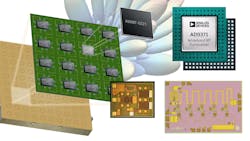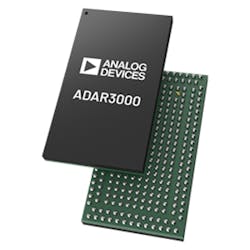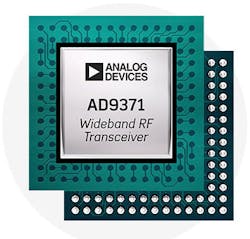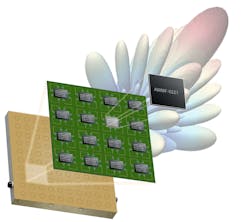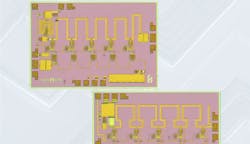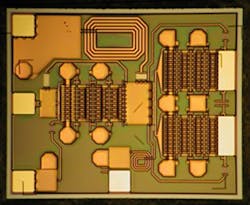RFICs and MMICs Aim at SWaP Targets
Members can download this article in PDF format.
What you’ll learn:
- RFICs and MMICs represent an avenue of opportunity for those seeking to optimize SWaP.
- These devices perform essential functions in many aspects of defense systems.
- The market is swirling with innovation in the form of new products with greater integration.
Solid-state devices and circuits have long been mainstays of aerospace and defense electronic systems, even in the face of rising signal frequencies and power levels. As military system designers become more concerned with smaller size, weight, and power (SWaP), they have looked to RF integrated circuits (RFICs) and monolithic microwave integrated circuits (MMICs) to provide more high-frequency functionality with higher efficiency. Among their applications are communications, electronic-warfare (EW), and radar systems, including those moving into space aboard satellites.
The trend in RFICs and MMICs for aerospace and defense use has been greater integration at higher frequencies, whether as bare die or in packages. Although major defense contractors, such as BAE Systems, Northrop Grumman, and Raytheon Technologies have their own gallium-nitride (GaN) and gallium-arsenide (GaAs) foundries, they rely on a variety of sources for different RFIC and MMICs to accomplish more with less in modern electronic systems.
Active RFICs and MMICs perform essential functions in defense systems for antennas, data conversion, frequency conversion/mixing, switching, signal generation, and amplification. Passive MMICs provide functions such as attenuation, coupling, and filtering. Multiple-function MMICs replace what had once required separate components. However, increased circuit density packs energy tighter and heat must be dissipated efficiently as part of any SWaP planning.
Whether as chips or in packages, ICs for aerospace and defense must be capable of difficult operating environments, such as operating temperatures from −55 to +85°C. ICs for space must meet even more challenging benchmarks, such as operating temperatures from −55 to +125°C, Class K and Class S parameters, and space-qualified MIL-PRF-38535 requirements. As needed for high-reliability (hi-rel) applications, RFICs and MMICs can be screened, for example, to even higher operating temperatures.
Meet the Makers
High-frequency industry developers and suppliers of RFICs and MMICs for military/aerospace and other applications are expected to be on hand at the 2022 Radio Frequency Integrated Circuits (RFIC) Symposium at the Colorado Convention Center (Denver). It’s scheduled for June 19-21, 2022, as part of “Microwave Week” during the 2022 IEEE International Microwave Symposium (IMS) when the Automatic RF Techniques Group (ARFTG) meeting brings together those interested in RF test and measurement methods.
One of the more diversified RFIC/MMIC portfolios for aerospace and defense belongs to Analog Devices. The company's ICs are based on GaAs, GaN, silicon (Si), and silicon-germanium (SiGe) substrates for functions such as clock generation and timing, data conversion, frequency generation, and signal amplification. Analog Devices promotes its IC products as an “antenna to bits” portfolio, with the assurance of full product testing by measure of digital test capabilities to 40 Gb/s and RF/microwave test capabilities to 110 GHz.
One of the company’s “simpler” RFICs is the ADAR3000, an antenna beamformer for transmit and receive operation from 17 to 22 GHz (Fig. 1). Time delays and step attenuation can be programmed to form 4 beams and 16 channels, with SPI computer control. While the antenna beamformer fits within a chip-scale BGA package, even more impressive is that the same BGA package contains an integrated analog-to-digital converter (ADC) and memory for storing beam positions. The beamformer IC has an operating temperature range of −40 to +85°C.
The same company’s model AD9371 wideband transceiver IC is a bit more complex, integrating multiple transmitters and receivers for applications from 0.3 to 6.0 GHz. It’s well-suited for commercial, industrial, and military applications including EW systems, portable radios, satcom systems, and data links in unmanned aerial vehicles (UAVs).
The MMIC, housed in a 196-ball chip-scale ball-grid-array (CS-BGA) package measuring just 12 × 12 mm, contains components for pairs of differential transmitters and receivers and several other receivers that at one time would have filled several 19-in.-wide equipment racks (Fig. 2). The various receivers handle bandwidths from 7.5 to 100.0 MHz, and the differential configuration allows for the use of frequency-division-duplex (FDD) and time-division-duplex (TDD) antenna systems.
Silicon ICs for Antennas
Anokiwave is well-versed in the design and production of active-antenna silicon ICs, especially beamforming ICs for phased-array antennas working through mmWave frequencies. The company’s ICs, which serve military and aerospace applications as well as commercial markets like satcom and 5G networks, are developed with goals of high performance, low cost, and small size in mind. The beamforming ICs provide precise control of signals to additional radiating elements as part of a phased-array antenna capable of directing and steering EM beams for receiving and transmitting purposes.
As an example, model AWS-0104 is an X-band beamforming IC that operates from 8.50 to 10.55 GHz. It connects to four radiating elements to form single beams for transmission and reception, with the operating mode controlled by an additional transmit/receive switch. Running from a single power supply, the IC provides 6-bit gain and phase control of the beams to steer and shape the beams during transmit and receive modes. The compact, low-power antenna solution targets communications radios and active electronically scanned array (AESA) radar systems.
At higher frequencies and with a bit more complexity, the firm also offers the AWMF-0221 dual-polarized Si CMOS beamforming IC for use from 24.25 to 29.50 GHz (Fig. 3). Designed to cover specific 3rd Generation Partnership Program (3GPP) bands, including n258, n257, and n261, in 5G networks, the IC can be operated with four dual-polarized or eight single-polarized channels, controlling radiating elements in a phased-array antenna. Its beamsteering controls are compliant with all 3GPP standards, and the IC is designed with strict carbon-neutrality goals in mind to support environmentally safe “green” electronic systems.
Renesas Electronics Corp. has developed several generations of silicon ICs for antenna beamforming applications, with separate ICs for radar and Ka- and Ku-band satcom receive and transmit beamforming functions as well as LNA MMICs to aid the receive functionality. The ICs are available as 16-channel, dual-beam receive beamformers (which can be programmed for single-beam use), and 8-channel transmit beamforming ICs.
The three receive beamformer ICs cover frequency bands of 10.70 to 12.75 GHz, 14.0 to 17.0 GHz, and 17.7 to 21.2 GHz, while the transmit ICs cover bands of 13.75 to 14.50 GHz, 14.0 to 17.0 GHz, and 27.5 to 31.0 GHz. Additional suppliers of RFICs for beamforming applications, although only for commercial bands and applications, include pSemi and Qualcomm.
Microsemi Corp., once a part of Microchip and now in the fold of Mercury Systems, offers a broad range of RFICs and MMICs including switches, prescalers, and frequency/phase detectors for EW, radar, and test applications from dc through 65 GHz. Its PFD1K phase frequency detector can be used with input frequency references and voltage-controlled oscillators from 10 MHz to 40 GHz to create phase-locked-loop (PLL) frequency sources.
The device packs a pair of 7-bit prescaler dividers and an 8-GHz phase frequency detector into a 6- × 6-mm ceramic QFN package. It runs on a single positive or negative 3.3-V dc supply and inputs and outputs can be used in single-ended or differential modes. The model MMS006AA GaAs MMIC single-pole, double-throw (SPDT) switch operates from dc to 20 GHz with less than 2-dB insertion loss and more than 40-dB isolation between ports. Typical switching speed is 10 ns.
Qorvo, created from the merger of former RF semiconductor innovators TriQuint Semiconductor and RF Micro Devices and the combination of Custom MMIC, also offers miniature packaged front-end modules for commercial communications and commercial and military radar systems. However, they’re achieved by integrating multiple amplifier, limiter, and transmit/receive switch dice within a multipin, surface-mount package.
The model QPF5005 front-end module spans 8 to 12 GHz with a receive noise figure of 2.2 dB and transmit power of +47 dBm (5 W). For those in need of more transmit power, model QPF5010 covers the same frequency range with the same receive noise figure, but it delivers typically +40 dBm (10 W) transmit power.
One product that made the transition from Custom MMIC, the model CMD310C3, is a subharmonically pumped MMIC mixer with integrated local oscillator (LO) housed within a leadless QFN package. It covers an RF range of 20 to 32 GHz with the LO operating at 10 to 16 GHz and yielding an intermediate-frequency (IF) range of dc to 6 GHz. The conversion loss and single-sideband (SSB) noise figure are both 8.5 dB, while the RF input power for 1-dB compression is +3 dBm. The mixer/LO MMIC draws 27 mA from a +4-V dc supply.
The company also offers GaAs MMICs in die form, such as the model CMD240 (Fig. 4), a distributed amplifier with more than 15 dB gain and low 2.2-dB noise figure from dc to 22 GHz. The chip amplifier is fully passivated for protection from damage caused by water vapor absorption in high humidity.
A relative newcomer, Viper RF, offers standard and custom discrete transistors and MMICs to 150 GHz, including the VRFC0127-BD C-band single-chip front-end MMIC. It operates from 5.2 to 5.6 GHz and integrates a transmit/receive switch, power amplifier, and LNA. Well-suited for radar and satcom, the receiver function achieves noise figure of 2.4 dB and small-signal gain of more than 35 dB at 5.4 GHz. The transmit saturated output power is typically +47 dBm at 5.4 GHz with power-added efficiency (PAE) of better than 40%. The front-end chip measures 5.89 × 6.70 mm.
Keep it Simple
Complex multifunction ICs can often replace larger, higher-power modules based on discrete components. RFICs and MMICs designated for military duty contribute to military electronic system SWaP goals by replacing single-function discrete components such as amplifiers, mixers, and switches, albeit with less power-handling capabilities.
For example, the MMA-012030 from MicroWave Technology Inc. is a broadband GaAs MMIC traveling-wave amplifier in die form. Measuring just 2350 × 1050 μm, it’s capable of 0.5 W (+27 dBm) output power at 1-dB compression from 0.1 to 20.0 GHz. The amplifier consumes 6 W power (0.5 A at +12 V dc) but maintains 12.5-dB gain flat within ±0.5 dB across the full wide bandwidth. It’s one example of an extensive line of broadband MMIC power amplifiers, driver amplifiers, and low-noise amplifiers (LNAs) in chip form for aerospace and defense applications.
Due to the difficulty of maintaining low amplifier noise figure over broad bandwidths, the firm offers die amplifiers such as the MLA-01122B GaAs MMIC LNA with optional 50-Ω on-chip impedance matching by means of microstrip interconnection to additional tuning stubs. The MMIC LNA, measuring 1.57 × 1.31 × 0.1 mm, is a good fit for EW and satcom receivers, drawing just 55 mA from a +5-V dc supply. It features 1.6-dB typical mid-band noise figure from 1 to 12 GHz with 17-dB gain that is flat within ±1.5 dB. Typical output power at 1-dB compression is +16.5 dBm.
Among the most broadband of MMIC amplifiers, the model MMA0035AA eight-stage traveling-wave die amplifier from Microsemi Corp. has a bandwidth of 0.04 to 65.00 GHz. It employs the company’s passive low-frequency extension (PLFX) on-chip circuitry to provide 10-dB small-signal gain flat within ±1.25 dB. It measures just 1640 × 920 μm but has an integrated power detector and dynamic gain control of better than 30 dB.
The amplifier draws 150 mA from a +7-V dc supply. It provides +15 dBm output power at 1-dB compression and +18-dBm saturated output power for extremely broadband applications in communications and EW systems requiring small-signal amplification.
United Monolithic Semiconductors offers LNAs in packaged form and PAs in die form based on GaN and GaAs materials. In die form, the model CHA8212-99F PA supports compact X-band EW and radar systems. It provides +44.5-dBm saturated output power from 8.5 to 11.5 GHz with 34-dB small-signal gain across the frequency range. It achieves 36% PAE at 7-dB compression while drawing 750 mA current from a +28-V dc supply.
For those in need of more bandwidth (but less power), the model CHA7618-99F delivers +40 dBm at 8-dB compression from 0.5 to 18.0 GHz with 30-dB gain. Also in die form, the PA achieves 24% PAE at 8-dB compression. It consumes 800 mA at +18 V dc.
Providing discrete transistors as well as MMIC amplifiers, in flange packages and as bare die, AMCOM Communications works with both GaN and GaAs substrates, too. The AM00010037WN-00 is a GaN MMIC PA with 13-dB small-signal gain from dc to 10 GHz and typical gain flatness of ±1.5 dB. It delivers +37-dBm saturated output power in bare die form with PAE of 23% at 5-dB compression (Fig. 5). Not common for PAs, it’s characterized for noise figure, which is quite respectable at 5 dB from 1 to 9 GHz. The MMIC PA draws 400-mA current from a +30-V dc supply.
Another long-time supplier of RFICs and MMICs, MACOM Technology Solutions recently announced that four of its manufacturing sites (in the U.S.) achieved AS9100D certification. The quality management system (QMS) standard, which builds on the ISO9001 military and space standard, designates the highest quality and repeatability of products from these manufacturing facilities, located in Massachusetts, Michigan, New Hampshire, and North Carolina.
MACOM offers a wide range of in-house designed and fabricated RFICs and MMICs as well as integrated assemblies based on those ICs and discrete semiconductors. Among its MMIC amplifiers, the MAAM02350-A2 is a GaAs MMIC PA in an 8-lead ceramic flatpack package. It operates from 0.2 to 3.0 GHz with +14-dBm output power at 1-dB compression and low noise figure of 4 dB. The gain is 18 dB and flat within ±0.75 dB across the full bandwidth.
The MMIC consists of two integrated gain stages with resistive feedback and requires no other external components other than a dc blocking capacitor for the power supply, which is +6 V dc. It typically draws 65 mA from the supply.
pSemi, which recently announced a series of RFICs for 5G frequency conversion and beamforming applications, has been a long-time supplier of single-function RFICs such as switches and phase shifters for military applications.
The PE44820 phase shifter, for example, provides precise phase control for weather and military radar systems from 1.7 to 2.2 GHz (with extended operation to 3.0 GHz). It’s well-suited for beamforming networks, distributed antenna systems, active antenna systems, and phased-array applications. Fabricated with the company’s silicon-on-insulator (SOI) CMOS technology, the RFIC’s 8-bit phase shifter provides steps as small as 1.4 degrees. It’s designed for temperatures as high as +105°C and holds RMS phase errors under 1 degree and amplitude errors to 0.1 dB or better. The phase shifter comes in a 5- × 5-mm QFN package.
A source not normally associated with GaAs technology—Keysight Technologies—provides one of the most broadband MMIC components, the dc-to-75-GHz model TC950 SPDT switch. Designed nominally for general-purpose and instrumentation applications, the switch also is a good fit for EW, ECM, and pulsed radar systems. The switch chip, which is fabricated with Microwave Technology’s GaAs pHEMT process, measures 630 × 930 μm. It has 2.6-dB insertion loss and 29-dB isolation at 50 GHz.
One of the RF industry’s most diversified suppliers of discrete high-frequency components, Mini-Circuits, also offers a wide array of RFICs and MMICs, typically in packaged form. The choice of component functions, such as amplifiers and switches, give system designers the flexibility to weigh overall system performance in quest of SWaP goals.
For example, model PMA-183PLN+ is a 6- to 18-GHz GaAs MMIC LNA in a 16-lead MCLP housing. It provides small-signal gain of typically 26.3 dB at 6 GHz, 27.5 dB at 15 GHz, and 29.7 dB at 18 GHz with noise figure of typically 1.4 dB at 6 GHz, 1.2 dB at 15 GHz, and 1.3 dB at 18 GHz. It draws 57.2 mA from a single 2.6-V dc supply.
When higher frequency coverage is required, the firm also supplies the model TSS-44+ MMIC amplifier with 17.6-dB typical gain that maintains ±0.9 gain flatness from 22.0 to 40.0 GHz. Typical noise figure is 3.7 dB to 40 GHz. The amplifier is supplied in a 3- × 3-mm MCLP surface-mount package with integrated dc blocks and bias tee.
Among the company’s other MMIC components are phase shifters and high-speed switches, such as the model M3SWA2-63DRC+ SPDT absorptive MMIC switch for applications from dc to 6 GHz. It operates on ±5-V dc supplies with 5.6-ns typical rise time and 6.0-ns typical fall time while suffering 1.3 dB or less insertion loss across the full frequency range. The isolation between output ports is 55 dB to 2 GHz and 37 dB to 4.5 GHz. The MMIC switch comes in a 12-lead package measuring 3 × 3 mm.
Conclusion
For the future, the DoD and DARPA are seeking higher-frequency internet access for defense communications systems, notably for many sensors expected to take advantage of Internet of Things (IoT) links via 5G networks. Some of the highest-frequency antenna ICs provide operation through 110 GHz for satellite links as well as data links with UAVs and unmanned ground vehicles (UGVs).
Still, more bandwidth is always needed and higher frequencies in the spectrum is the place where it’s at. This includes the G-band (110 to 300 GHz), where programs such as DARPA’s Electronics for G-Band Arrays (ELGAR) project are seeking future MMIC developments.
About the Author
Jack Browne
Technical Contributor
Jack Browne, Technical Contributor, has worked in technical publishing for over 30 years. He managed the content and production of three technical journals while at the American Institute of Physics, including Medical Physics and the Journal of Vacuum Science & Technology. He has been a Publisher and Editor for Penton Media, started the firm’s Wireless Symposium & Exhibition trade show in 1993, and currently serves as Technical Contributor for that company's Microwaves & RF magazine. Browne, who holds a BS in Mathematics from City College of New York and BA degrees in English and Philosophy from Fordham University, is a member of the IEEE.
